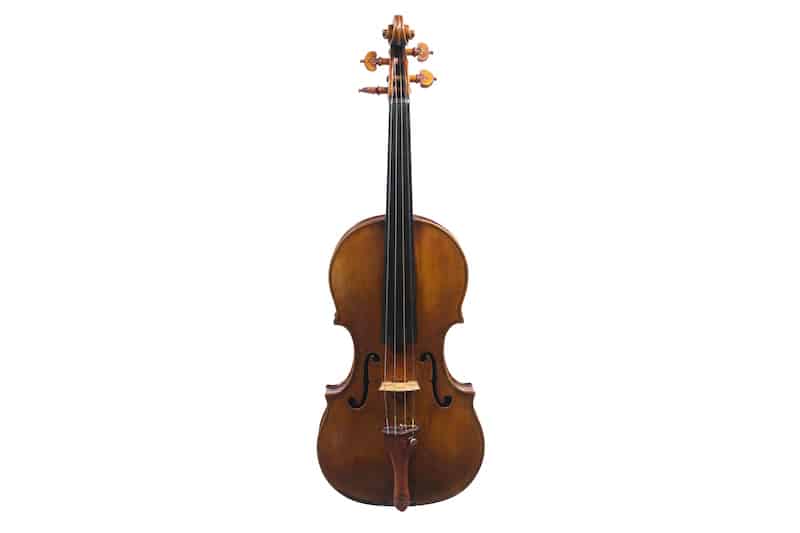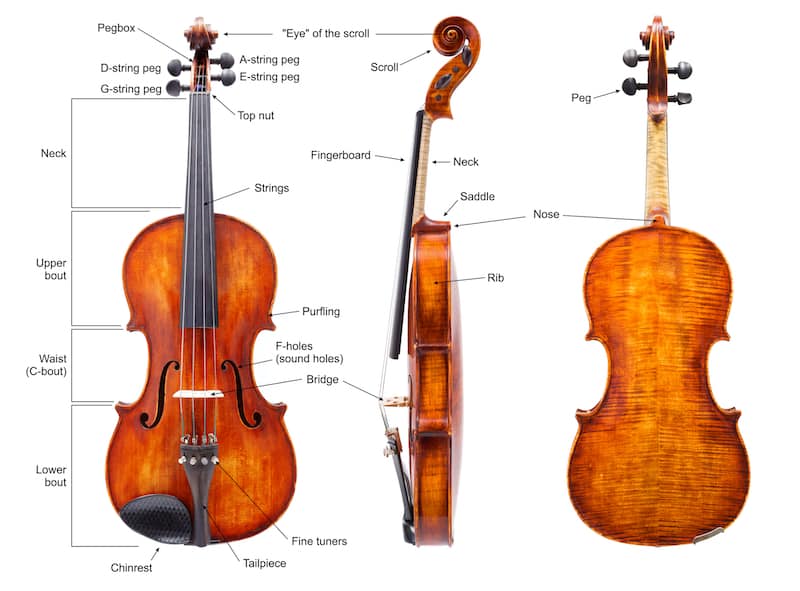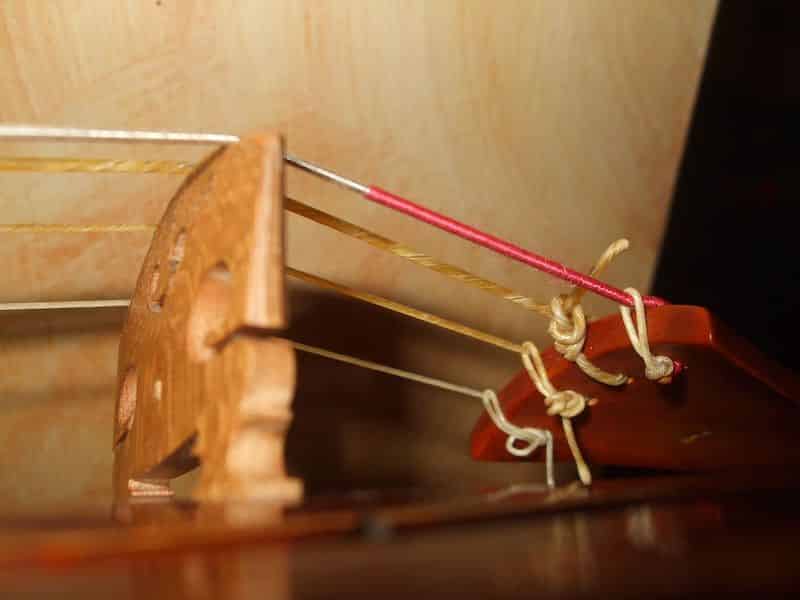The violin, while being a well loved and impressive instrument, dates back to the 1500s and has a fascinating history. This article will outline some of the most interesting facts about the violin that have emerged throughout its lifetime, including the age of the oldest violin, why strings used to be made from dried sheep guts and how many millions the most expensive violin in the world sold for.
1. The Violin is Almost 500 Years Old

The Violin has a long history, but its elegant shape and design is credited to Andrea Amati, who is thought to be the founding father of violin luthiers.
His work dates back to the 1500’s and defined violin craftsmanship, and went on to influence the designs of celebrated luthier, Antonio Stradivari.
The oldest violin remaining today is of Amati design and dates back to 1560 (shown above).
Paintings from this era suggest that similar stringed instruments from the renaissance period existed before this date, such as the rebec, renaissance violin and the lira.
Amati incorporated features from a rebec into his design, such as strings tuned in intervals of a fifth, whilst adopting the figure of eight shape of a renaissance fiddle.
Since Amati established the modern violin, the design has barely changed, as it was considered to be so masterful.
However, the art of violin making is celebrated to have been at its peak in the hands of Amati’s contemporary, Antonio Stradivari.
His creations took on his name sake, Stradivarius, and are widely renowned.
2. Violins can get VERY Expensive
The most expensive violin in the world dates back to 1741, made by luthier Giuseppe Guarneri and played by Belgian virtuoso, Henry Vieuxtemps.
It is named the Vieuxtemps Guaneri after these two men and has been valued at a whopping $18 million (£10.5 million)!
It was anonymously donated to famous American violinist, Anne Aikko Meyers, loaned in perpetuity for the rest of her life.
She debuted this impressive instrument by recording Vivaldi’s Four Seasons.
3. Violins are Named After Cows
The word ‘violin’ originates from the Latin word, ‘vitula’, which translates into ‘calf’ or cow.
This may have referred to the fact that it was dried animal guts (sheep and cow) that were used to create the strings of the instrument.
However, the word, ‘vitula’ also has connotations with the Roman Goddess, Sabine Vitula, of joy and victory, which is certainly a more pleasant association.
4. Violin Strings Aren’t Always Vegan
Incredible though it seems now, violin strings were originally made from dried animal intestines!
The common use of intestines or guts (where the term ‘gut strings’ comes from) can be dated back to Ancient Egypt, after hieroglyphs were discovered, detailing the production of dried gut.
This only changed after the second world war, when alternative materials, such as aluminum, steel, silver and chrome were used to coat synthetic strings although you can still get real gut strings today.
These mimicked the rich sounding timbre of the gut strings, while the metal coating increased their durability.
5. Playing the Violin is a Work out
According to a research study, playing the violin burns around 170 calories per hour.
This is equivalent to two glasses of wine or 20% of a big Mac from McDonalds (with cheese).
This may not constitute vigorous exercise, but practicing the violin will expend energy as much of your upper body is working when you play.
Just think how many calories a full day of orchestra rehearsals will burn!
6. Mozart was an Accomplished Violinist

Although Mozart was famously an outstanding classical period composer and pianist, he was also an accomplished violinist, and performed to a high standard.
Mozart’s father, also a highly skilled violinist, was highly involved in his musical education, and brought him along to his own performances around Europe.
Wolfgang Amadeus Mozart performed concerts on the violin, and composed technically advanced pieces using his knowledge of the instrument.
Additionally, Mozart learned how to play the viola, and is often celebrated for making viola parts more interesting and dominant than they might typically be.
7. Violinists used to be Conductors
The first violinist in an orchestra used to act as conductor or concert master, until the role of the conductor became established in the 1900s.
The lead violinist would direct musicians from their seat at the front, or from a standing position.
This gradually changed as orchestras got larger, and there were increasing numbers of musicians to direct.
The joint role of conducting and demonstrating orchestral parts to perfection was very demanding, and so it is not surprising that a separate role was created so that the first violinist could give their full attention to musical performance.
8. Violin or Fiddle?
It’s a common misconception that the violin and the fiddle are different types of violin, however, they are exactly the same instrument, but represent different styles of music and different playing techniques.
The fiddle is often associated with folk music and played in a less formal style than classical violin, which is associated with orchestras and chamber music.
Some fiddles have minor adjustments such as a flatter bridge, to make double stopping (play two strings at once) easier, which is a characteristic feature of the folk genre.
However, the two instruments are the same in design, but played differently.
The bow technique differs between the two, with folk music requiring a looser hold, and classical music requiring a range of more controlled movements and a cleaner sound.
9. The Violin is Made up of 81 Pieces

Violin’s are notoriously complicated to make and materials must be sourced from specialist suppliers.
Violins are made with up to 81 different pieces of wood, not counting any extra pieces if they have been repaired.
A typical violin uses a variety of woods, including maple, spruce and ebony, and may incorporate rosewood and boxwood too.
Making a violin is a lengthy process, taking over 10 weeks to complete the building, tanning and varnishing processes.
Becoming a Luthier requires special training and often three years of learning before starting their professional career.
10. The Interesting Story of Fritz Kreisler
One of the most famous and virtuosic violinists, Fritz Kreisler, served in WWI as a captain.
He put his career as a rising violinist star to one side to serve in the military in Austria.
However, while on the front lines his musical ear was not wasted.
Kreisler wrote in his account of the war how he was able to calculate the approximate location of where shells had been fired from by the noise that they made as they ascended and then descended on their trajectory.
Kreisler was sent on a special mission by his commanding officer and was successfully able to calculate the range and location of the Russian artillery.
Summing up Violin Facts
That’s it for the most interesting facts about the violin!
We hope you have learned something new about this fascinating instrument and also that it gives you renewed appreciation for the modern invention of synthetic strings!
Remember that an extra hour of practice will certainly justify having that second helping of dessert or glass of wine!


